Circle of Willis
| Circle of Willis | |
|---|---|
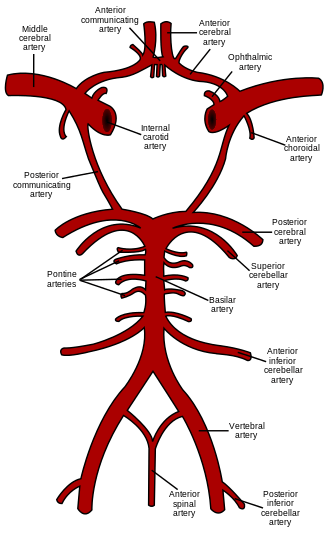 Schematic representation of the circle of Willis, arteries of the brain and brain stem. Blood flows up to the brain through the vertebral arteries and through the internal carotid arteries. | |
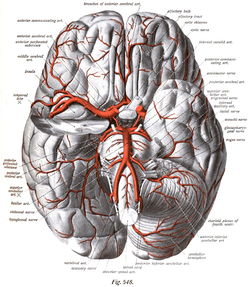 The arteries of the base of the brain. Basilar artery labeled below center. The temporal pole of the cerebrum and the cerebellar hemisphere have been removed on the right side. Inferior aspect (viewed from below). | |
| Details | |
| Identifiers | |
| Latin |
Circulus arteriosus cerebri Circulus Willisi |
| MeSH | A07.231.114.228.351 |
| TA | A12.2.07.080 |
| FMA | 50454 |
The circle of Willis (also called Willis' circle, loop of Willis, cerebral arterial circle, and Willis polygon) is a circulatory anastomosis that supplies blood to the brain and surrounding structures. It is named after Thomas Willis (1621–1675), an English physician.[1]
Structure
The circle of Willis is a part of the cerebral circulation and is composed of the following arteries:[2]
- Anterior cerebral artery (left and right)
- Anterior communicating artery
- Internal carotid artery (left and right)
- Posterior cerebral artery (left and right)
- Posterior communicating artery (left and right)
The middle cerebral arteries, supplying the brain, are not considered part of the circle.
Origin of arteries
The left and right internal carotid arteries arise from the left and right common carotid arteries.
The posterior communicating artery is given off as a branch of the internal carotid artery just before it divides into its terminal branches - the anterior and middle cerebral arteries. The anterior cerebral artery forms the anterolateral portion of the circle of Willis, while the middle cerebral artery does not contribute to the circle.
The right and left posterior cerebral arteries arise from the basilar artery, which is formed by the left and right vertebral arteries. The vertebral arteries arise from the subclavian arteries.
The anterior communicating artery connects the two anterior cerebral arteries and could be said to arise from either the left or right side.
All arteries involved give off cortical and central branches. The central branches supply the interior of the circle of Willis, more specifically, the Interpeduncular fossa. The cortical branches are named for the area they supply. Since they do not directly affect the circle of Willis, they are not dealt with here.
Variation
Considerable anatomic variation exists in the circle of Willis. Based on a study of 1413 brains, the classic anatomy of the circle is only seen in 34.5% of cases.[3] In one common variation the proximal part of the posterior cerebral artery is narrow and its ipsilateral posterior communicating artery is large, so the internal carotid artery supplies the posterior cerebrum. In another variation the anterior communicating artery is a large vessel, such that a single internal carotid supplies both anterior cerebral arteries.
Function
The arrangement of the brain's arteries into the circle of Willis creates redundancies or collaterals in the cerebral circulation. If one part of the circle becomes blocked or narrowed (stenosed) or one of the arteries supplying the circle is blocked or narrowed, blood flow from the other blood vessels can often preserve the cerebral perfusion well enough to avoid the symptoms of ischemia.[4]
Clinical significance
Aneurysms
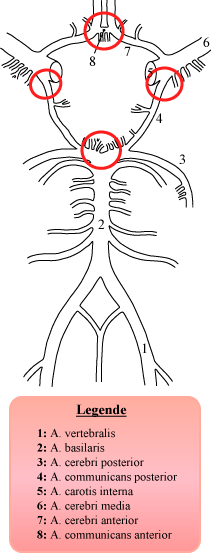
Subclavian steal syndrome
The redundancies that the circle of Willis introduce can also lead to reduced cerebral perfusion.[5][6] In subclavian steal syndrome, blood is "stolen" from the circle of Willis to preserve blood flow to the upper limb. Subclavian steal syndrome results from a proximal stenosis (narrowing) of the subclavian artery, an artery supplied by the aorta which is also the same blood vessel that eventually feeds the circle of Willis via the vertebral artery.
Additional images
 Fetal ultrasound image at the level of circle of Willis, showing PCA, MCA and ACA
Fetal ultrasound image at the level of circle of Willis, showing PCA, MCA and ACA- Cerebral angiogram showing an anterior/posterior projection of the vertebrobasilar and posterior cerebral circulation, the posterior aspect of the circle of Willis and one of its feeding vessels.
 An anterior view of major cerebral and cerebellar arteries.
An anterior view of major cerebral and cerebellar arteries.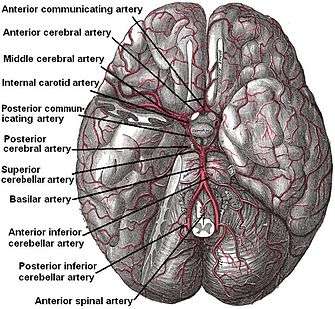
 Circle of Willis
Circle of Willis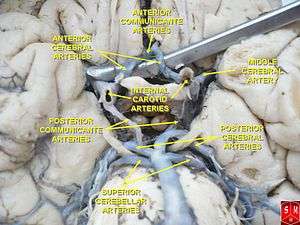 Circle of Willis
Circle of Willis
References
- ↑ Uston, Cagatay (February 20, 2004). "Dr. Thomas Willis' Famous Eponym: The Circle of Willis" (PDF). Turkish Journal of Medical Sciences. 34: 271–274. Retrieved 16 July 2010.
- ↑ Purves, Dale; George J. Augustine; David Fitzpatrick; William C. Hall; Anthony-Samuel LaMantia; James O. McNamara; Leonard E. White (2008). Neuroscience, 4th Ed. Sinauer Associates. pp. 834–5. ISBN 978-0-87893-697-7.
- ↑ Bergman RA, Afifi AK, Miyauchi R, Circle of Willis. Illustrated Encyclopedia of Human Anatomic Variation, URL: http://www.anatomyatlases.org/AnatomicVariants/Cardiovascular/Text/Arteries/CircleofWillis.shtml. Accessed on November 6, 2005.
- ↑ Boorder, Michiel J.; Van Der Grond, J; Van Dongen, AJ; Klijn, CJ; Jaap Kappelle, L; Van Rijk, PP; Hendrikse, J (2006). "Spect measurements of regional cerebral perfusion and carbon dioxide reactivity: Correlation with cerebral collaterals in internal carotid artery occlusive disease". J Neurol. 253 (10): 1285–1291. doi:10.1007/s00415-006-0192-1. PMID 17063318.
- ↑ Klingelhöfer, J; Conrad, B; Benecke, R; Frank, B (1988). "Transcranial Doppler ultrasonography of carotid-basilar collateral circulation in subclavian steal". Stroke; a journal of cerebral circulation. 19 (8): 1036–42. doi:10.1161/01.STR.19.8.1036. PMID 3041649.
- ↑ Lord, RS; Adar, R; Stein, RL (1969). "Contribution of the circle of Willis to the subclavian steal syndrome". Circulation. 40 (6): 871–8. doi:10.1161/01.CIR.40.6.871. PMID 5377222.
See also
| Wikimedia Commons has media related to Circle of Willis. |